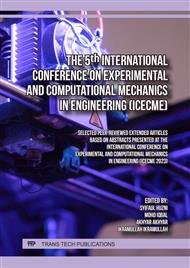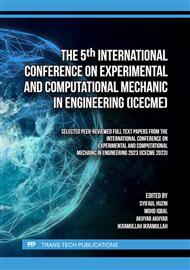[1]
M. C. Karam, J. Petit, D. Zimmer, E. B. Djantou, and J. Scher, "Effects of drying and grinding in production of fruit and vegetable powders: A review," J. Food Eng., vol. 188, p.32–49, 2016.
DOI: 10.1016/j.jfoodeng.2016.05.001
Google Scholar
[2]
B. A. Weinberg and B. K. Bealer, The world of caffeine: the science and culture of the world's most popular drug. Routledge, 2004.
Google Scholar
[3]
A. Farah, "Flavor development during roasting," in Drying and Roasting of Cocoa and Coffee, CRC press, 2019, p.267–309.
DOI: 10.1201/9781315113104-9
Google Scholar
[4]
S. Viljoen, "Sensory profiling of selected Arabica coffees (Coffea arabica) of different Africa origins." University of Pretoria (South Africa), 2019.
Google Scholar
[5]
L. Poisson, I. Blank, A. Dunkel, and T. Hofmann, "The chemistry of roasting—Decoding flavor formation," in The craft and science of coffee, Elsevier, 2017, p.273–309.
DOI: 10.1016/b978-0-12-803520-7.00012-8
Google Scholar
[6]
E. Nebesny and G. Budryn, "Evaluation of sensory attributes of coffee brews from robusta coffee roasted under different conditions," Eur. Food Res. Technol., vol. 224, p.159–165, 2006.
DOI: 10.1007/s00217-006-0308-y
Google Scholar
[7]
J. B. Park, R. Peters, and J. A. Novotny, "Impact of roasting on javamide-I/-II in Arabica and Robusta coffee beans," Food Chem., vol. 412, p.135586, 2023.
DOI: 10.1016/j.foodchem.2023.135586
Google Scholar
[8]
G. Won Kang, Z. (Zoey) Piao, and J. Youn Ko, "Effects of water types and roasting points on consumer liking and emotional responses toward coffee," Food Qual. Prefer., vol. 101, p.104631, 2022.
DOI: 10.1016/j.foodqual.2022.104631
Google Scholar
[9]
L. Anokye-Bempah, J. Han, K. Kornbluth, W. Ristenpart, and I. R. Donis-González, "The use of desiccants for proper moisture preservation in green coffee during storage and transportation," J. Agric. Food Res., vol. 11, p.100478, 2023.
DOI: 10.1016/j.jafr.2022.100478
Google Scholar
[10]
A. Hameed, S. A. Hussain, M. U. Ijaz, S. Ullah, I. Pasha, and H. A. R. Suleria, "Farm to consumer: factors affecting the organoleptic characteristics of coffee. II: postharvest processing factors," Compr. Rev. Food Sci. Food Saf., vol. 17, no. 5, p.1184–1237, 2018.
DOI: 10.1111/1541-4337.12365
Google Scholar
[11]
P. C. Corrêa, G. H. H. Oliveira, P. L. Rodrigues, S. C. Campos, and F. M. Botelho, "Hygroscopic equilibrium and physical properties evaluation affected by parchment presence of coffee grain," Spanish J. Agric. Res., vol. 8, no. 3, p.694–702, 2010.
DOI: 10.5424/sjar/2010083-1267
Google Scholar
[12]
S. Smrke, J. Adam, S. Mühlemann, I. Lantz, and C. Yeretzian, "Effects of different coffee storage methods on coffee freshness after opening of packages," Food Packag. Shelf Life, vol. 33, p.100893, 2022.
DOI: 10.1016/j.fpsl.2022.100893
Google Scholar
[13]
E. Makri, D. Tsimogiannis, E. K. Dermesonluoglu, and P. S. Taoukisa, "Modeling of Greek coffee aroma loss during storage at different temperatures and water activities," Procedia Food Sci., vol. 1, p.1111–1117, 2011.
DOI: 10.1016/j.profoo.2011.09.166
Google Scholar
[14]
P. Tapangnoi, P. Sae-Oui, W. Naebpetch, and C. Siriwong, "Preparation of purified spent coffee ground and its reinforcement in natural rubber composite," Arab. J. Chem., vol. 15, no. 7, p.103917, 2022.
DOI: 10.1016/j.arabjc.2022.103917
Google Scholar
[15]
S. B. Kang, H. Y. Oh, J. J. Kim, and K. S. Choi, "Characteristics of spent coffee ground as a fuel and combustion test in a small boiler (6.5 kW)," Renew. Energy, vol. 113, p.1208–1214, 2017.
DOI: 10.1016/j.renene.2017.06.092
Google Scholar
[16]
R. Campos-Vega, G. Loarca-Piña, H. A. Vergara-Castañeda, and B. D. Oomah, "Spent coffee grounds: A review on current research and future prospects," Trends Food Sci. Technol., vol. 45, no. 1, p.24–36, 2015.
DOI: 10.1016/j.tifs.2015.04.012
Google Scholar
[17]
M. Charai, O. Horma, A. El Hammouti, A. Mezrhab, and M. Karkri, "Thermophysical characteristics of cement-based mortar incorporating spent coffee grounds," Mater. Today Proc., vol. 57, p.867–870, 2022.
DOI: 10.1016/j.matpr.2022.02.488
Google Scholar
[18]
N. A. Febrianto and F. Zhu, "Coffee bean processing: Emerging methods and their effects on chemical, biological and sensory properties," Food Chem., vol. 412, p.135489, 2023.
DOI: 10.1016/j.foodchem.2023.135489
Google Scholar
[19]
H. Sosiati, M. Kosasih, A. Pamasti, R. K. Adi, S. Hamdan, and Y. Yusuf, "Properties of Abaca/Epoxy Composites Modified by Activated Carbon Particles for Orthosis Application," BioResources, vol. 18, no. 4, p.7510–7523, 2023.
DOI: 10.15376/biores.18.4.7510-7523
Google Scholar
[20]
A. D. Nugraha et al., "Investigating the mechanical properties and crashworthiness of Hybrid PLA/GFRP Composites Fabricated Using FDM-Filament Winding," Heliyon, 2024.
DOI: 10.1016/j.heliyon.2024.e39062
Google Scholar
[21]
H. Sosiati, A. M. Rizky, A. L. M. Latief, R. K. Adi, and S. Hamdan, "The mechanical and physical properties of microcrystalline cellulose (MCC)/sisal/PMMA hybrid composites for dental applications," Mater. Res. Express, vol. 10, no. 3, p.35301, 2023.
DOI: 10.1088/2053-1591/acbb57
Google Scholar
[22]
M. Ho et al., "Critical factors on manufacturing processes of natural fibre composites," Compos. Part B Eng., vol. 43, no. 8, p.3549–3562, 2012.
Google Scholar
[23]
F. Ma et al., "Determining peanut moisture content by scattering coefficient," J. Food Eng., vol. 344, p.111398, 2023.
DOI: 10.1016/j.jfoodeng.2022.111398
Google Scholar
[24]
G. A. Collazos-Escobar, N. Gutiérrez-Guzmán, H. A. Váquiro-Herrera, J. Bon, and J. V Garcia-Perez, "Thermodynamic analysis and modeling of water vapor adsorption isotherms of roasted specialty coffee (Coffee arabica L. cv. Colombia)," LWT, vol. 160, p.113335, 2022.
DOI: 10.1016/j.lwt.2022.113335
Google Scholar
[25]
B. Zani Agnoletti et al., "Effect of fermentation on the quality of conilon coffee (Coffea canephora): Chemical and sensory aspects," Microchem. J., vol. 182, p.107966, 2022.
DOI: 10.1016/j.microc.2022.107966
Google Scholar
[26]
N. Caporaso, M. B. Whitworth, S. Grebby, and I. D. Fisk, "Rapid prediction of single green coffee bean moisture and lipid content by hyperspectral imaging," J. Food Eng., vol. 227, p.18–29, 2018.
DOI: 10.1016/j.jfoodeng.2018.01.009
Google Scholar
[27]
Y. Sun, Y. Huang, T. Lu, and X. Chen, "Temporal kinetics of changes in color, phytochemicals, γ-aminobutyric acid, enzyme activity and antioxidant activity of coffee leaves during postharvest storage," Sci. Hortic. (Amsterdam)., vol. 304, p.111360, 2022.
DOI: 10.1016/j.scienta.2022.111360
Google Scholar
[28]
P. Tripetch and C. Borompichaichartkul, "Effect of packaging materials and storage time on changes of colour, phenolic content, chlorogenic acid and antioxidant activity in arabica green coffee beans (Coffea arabica L. cv. Catimor)," J. Stored Prod. Res., vol. 84, p.101510, 2019.
DOI: 10.1016/j.jspr.2019.101510
Google Scholar
[29]
A. N. Yüksel, K. T. Özkara Barut, and M. Bayram, "The effects of roasting, milling, brewing and storage processes on the physicochemical properties of Turkish coffee," LWT, vol. 131, p.109711, 2020.
DOI: 10.1016/j.lwt.2020.109711
Google Scholar
[30]
G. F. Abreu, F. M. Borém, L. F. C. Oliveira, M. R. Almeida, and A. P. C. Alves, "Raman spectroscopy: A new strategy for monitoring the quality of green coffee beans during storage," Food Chem., vol. 287, p.241–248, 2019.
DOI: 10.1016/j.foodchem.2019.02.019
Google Scholar
[31]
D. de C. Lopes and A. J. Steidle Neto, "Modelling the dry matter loss of coffee beans under different storage conditions," J. Stored Prod. Res., vol. 88, p.101669, 2020.
DOI: 10.1016/j.jspr.2020.101669
Google Scholar
[32]
M. Y. Rendón, T. de Jesus Garcia Salva, and N. Bragagnolo, "Impact of chemical changes on the sensory characteristics of coffee beans during storage," Food Chem., vol. 147, p.279–286, 2014.
DOI: 10.1016/j.foodchem.2013.09.123
Google Scholar
[33]
M. Maman, S. Sangchote, O. Piasai, W. Leesutthiphonchai, H. Sukorini, and N. Khewkhom, "Storage fungi and ochratoxin A associated with arabica coffee bean in postharvest processes in Northern Thailand," Food Control, vol. 130, p.108351, 2021.
DOI: 10.1016/j.foodcont.2021.108351
Google Scholar
[34]
M. Okamura, M. Soga, Y. Yamada, K. Kobata, and D. Kaneda, "Development and evaluation of roasting degree prediction model of coffee beans by machine learning," Procedia Comput. Sci., vol. 192, p.4602–4608, 2021.
DOI: 10.1016/j.procs.2021.09.238
Google Scholar
[35]
W. Dong et al., "Comparative evaluation of the volatile profiles and taste properties of roasted coffee beans as affected by drying method and detected by electronic nose, electronic tongue, and HS-SPME-GC-MS," Food Chem., vol. 272, p.723–731, 2019.
DOI: 10.1016/j.foodchem.2018.08.068
Google Scholar
[36]
Y. Wang et al., "Anaerobic germination of green coffee beans: A novel strategy to improve the quality of commercial Arabica coffee," Curr. Res. Food Sci., vol. 6, p.100461, 2023.
DOI: 10.1016/j.crfs.2023.100461
Google Scholar
[37]
M. Anese et al., "Influence of coffee roasting degree on inflammatory and oxidative stress markers in high-fructose and saturated fat-fed rats," Food Res. Int., vol. 165, p.112530, 2023.
DOI: 10.1016/j.foodres.2023.112530
Google Scholar
[38]
N. K. Donovan, K. A. Foster, and C. A. Parra Salinas, "Analysis of green coffee quality using hermetic bag storage," J. Stored Prod. Res., vol. 80, p.1–9, 2019.
DOI: 10.1016/j.jspr.2018.11.003
Google Scholar
[39]
F. C. Ribeiro, F. M. Borém, G. S. Giomo, R. R. De Lima, M. R. Malta, and L. P. Figueiredo, "Storage of green coffee in hermetic packaging injected with CO2," J. Stored Prod. Res., vol. 47, no. 4, p.341–348, 2011.
DOI: 10.1016/j.jspr.2011.05.007
Google Scholar
[40]
A. Alamsyah et al., "Blockchain traceability model in the coffee industry," J. Open Innov. Technol. Mark. Complex., vol. 9, no. 1, p.100008, 2023.
DOI: 10.1016/j.joitmc.2023.100008
Google Scholar
[41]
P. M. M. Martins, N. N. Batista, L. D. Santos, D. R. Dias, and R. F. Schwan, "Microencapsulation of epiphytic coffee yeasts by spray drying using different wall materials: Implementation in coffee medium," Int. J. Food Microbiol., vol. 379, p.109839, 2022.
DOI: 10.1016/j.ijfoodmicro.2022.109839
Google Scholar
[42]
A. A. Tassew, G. B. Yadessa, A. D. Bote, and T. K. Obso, "Influence of location, elevation gradients, processing methods, and soil quality on the physical and cup quality of coffee in the Kafa Biosphere Reserve of SW Ethiopia," Heliyon, vol. 7, no. 8, p. e07790, 2021.
DOI: 10.1016/j.heliyon.2021.e07790
Google Scholar
[43]
H. Sosiati, A. M. Rizky, A. L. M. Latief, R. K. Adi, and S. Hamdan, "The mechanical and physical properties of microcrystalline cellulose (MCC)/sisal/PMMA hybrid composites for dental applications," Mater. Res. Express, vol. 10, no. 3, 2023.
DOI: 10.1088/2053-1591/acbb57
Google Scholar



